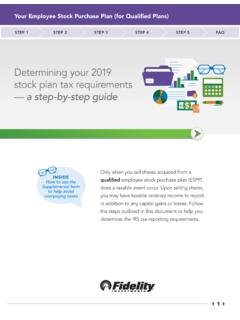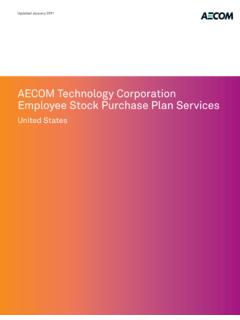Transcription of Employee Stock Purchase Plans and the Calculation of Basic ...
1 A C C O U N T I N G & A U D I T I N G. accounting Employee Stock Purchase Plans and the Calculation of Basic and Diluted Earnings per Share By Josef Rashty E. arnings per share (EPS) is the most common and complex performance measurement that a publicly held company presents in its quarterly and annu- al reports (Josef Rashty and John O'Shaughnessy, Restricted Stock Units and the Calculation of Basic and Diluted Earnings per Share, The CPA Journal, June 2011, pp. 40 45). Guidance for calculating and reporting EPS can be found in two parts of the Accounting Standards Codification (ASC): Topic 260, Earnings per Share, . which provides for the Calculation and presentation of the Basic and diluted EPS, and Topic 718, Compensation Stock Compensation, which provides for certain unique characteristics of Stock compensa- tion that impact the EPS Calculation .
2 ASC 260 defines EPS as the amount of income attributable to each share of com- mon Stock . Basic EPS is calculated by divid- ing net income by the weighted average of the number of common Stock shares out- standing during the period, whereas diluted EPS includes all dilutive potential common shares that are outstanding during the peri- od. Generally, unvested equity awards that companies have granted to their employees are not included in the Calculation of Basic EPS, even though such contingent awards are legally considered outstanding. These (ESPP) on the Calculation of diluted EPS, granted at the beginning of the period at a awards are usually included in Calculation of and there is diversity in actual practice. defined price and their vesting is subject diluted EPS, however. Some companies have allocated the num- to continuation of service.
3 This article has ASC 718 impacts both the EPS numer- ber of ESPP shares ratably over the pur- followed the conceptual framework of ator (net income) and the denominator (the chase period in order to provide for the ASC 718 for Stock options to define the average number of shares outstanding). dilutive effect of ESPP shares, while oth- diluting impact of ESPPs. Stock compensation not only reduces the ers have treated this Calculation in a fash- Some software programs used for the net income and income tax expense, but ion similar to other forms of equity awards. Calculation of Stock -based compensation also impacts the amount of proceeds in the Although ESPP awards are a form of and EPS do not have the special features treasury Stock method (TSM) Calculation incentive Stock option (ISO), they possess needed to accommodate the specific that determines the average number of some unique characteristics that impact the requirements of ESPP Calculation .
4 Shares outstanding. Calculation of diluted EPS. Companies must ensure that these pro- No specific guidance exists regarding the ASC 718 treats ESPP awards as ISOs grams are designed and implemented in impact of Employee Stock Purchase Plans because these awards, like options, are such a way that they can provide for the 32 MAY 2012 / THE CPA JOURNAL. impact of ESPPs on the number of shares An interim-period adjustment is not very EPS Calculation outstanding, particularly if the dilutive common, unless there is a substantial Because there is no specific guidance effect is material or is expected to change in the operation and structure of the regarding the impact of ESPP on the cal- become material in certain periods. The fol- company for example, if a company has culation of diluted EPS, the general guid- lowing discussion provides a framework to gone through a major restructuring, mass ance for inclusion of options in the calcu- help CPAs incorporate some of the best layoff, and closure of certain facilities.
5 Lation of diluted EPS prevails. According practices for accounting for the dilutive to ASC 260-45-28A: effect of ESPPs. ESPP Tax Considerations Awards of share options and nonvested ESPPs, like ISOs, are awards that meet shares (as defined in Topic 718) to be How ESPPs Work specific IRS requirements for classification issued to an Employee under a share-based ESPPs are designed to promote employ- as statutory Stock options. There is no tax compensation arrangement are considered ee Stock ownership by providing employ- due to employees at the time they are options for purposes of computing dilut- ees with a convenient means (usually granted. When the employer transfers the ed EPS. Such share-based awards shall be through a payroll deduction) to acquire a shares to employees at the end of the offer- considered to be outstanding as of the company's shares.
6 An ESPP is a contrac- ing period, the Employee is taxed on the grant date for purposes of computing dilut- tual promise that permits an Employee to spread ( , the difference between the pur- ed EPS even though their exercise may acquire an employer's Stock on a future chase price and fair value of the Stock ). be contingent upon vesting. date under the terms and conditions Therefore, from a tax accounting perspec- As previously mentioned, ESPPs are established on the grant date. An ESPP also tive, ESPPs are considered permanent dif- treated as ISOs under ASC 718 because allows employees to set aside a certain per- ferences, and no deferred tax assets (DTA) they are granted at the beginning of the centage of their compensation over an are recorded when they are expensed. period at a defined price and their vest- offering period (usually one year or less) If an Employee completes a qualifying ing is subject to continuation of service.
7 In order to Purchase their company's Stock . disposition whereby the Employee sells Therefore, all ESPP contributions prior An employer then uses the withheld the Stock at least two years after the grant to vesting are subject to a diluted EPS. amounts to acquire the company's Stock date and one year after the date of exer- Calculation , but they will not be includ- from the market at a discounted rate at cise or Purchase (the statutory holding peri- ed in a Basic EPS Calculation until the the end of the offering period and deliv- od) the Employee will recognize capital company delivers the shares to employ- ers the Stock to employees. gains instead of ordinary income on the The discount is typically applied to the sale of the Stock . If, on the other hand, lesser of the beginning or ending of the the Employee sells the Stock before the offering period Stock price.
8 Companies usu- statutory holding period ends, the sale ally allow enrolled employees to withdraw will be a disqualifying disposition, and their contributed funds prior to the end of the Employee will recognize ordinary the offering period for various reasons, income, which is taxed at a higher rate. including possible termination or emer- If the employer has granted statutory gency. Some companies even allow Stock options ( , ISOs or ESPPs), it employees to reduce their contribution per- will receive a tax deduction only upon a centage during the offering period. disqualifying disposition. If there is a dis- qualifying disposition, the employer will ESPP Compensation Expense be entitled to a tax deduction if 1) the At the beginning of the ESPP offering Employee recognizes ordinary income at period, management must estimate the the time of sale and 2) the employer reports number of shares of Stock that employees the income.
9 An employer must be able to will eventually Purchase under an ESPP satisfy the requirements of Internal program. This estimate is based on the Revenue Code (IRC) section 6041 by pro- employees' withholding elections, status viding the Employee with a Form W-2 or changes, and the existing Stock price. Form W-2(c) whichever is appropriate . Companies usually use the Black-Scholes- and then filing the form with the IRS by Merton valuation model to calculate the the date that the employer files the tax compensation cost for ESPP at the begin- return, claiming the deduction related to ning of the period. the disqualifying disposition. Companies amortize the estimated com- Neither qualified nor disqualified disposi- pensation expense ratably over the offer- tions of ESPPs impact the Calculation of dilut- ing period.
10 They also perform a cumula- ed EPS. Because no DTAs are recorded at tive one-time adjustment for compensation the time of commitment for the Purchase of cost based on the actual number of shares shares, there is no tax consideration in the granted at the end of the offering period. Calculation of diluted EPS for ESPPs. MAY 2012 / THE CPA JOURNAL 33. ees participating in the ESPP program prevesting forfeiture reserve does not, how- Basic EPS Calculation upon vesting. ever, impact the Calculation of the assumed According to ASC 260-10-45: Since ESPPs are service-based awards, proceeds under the treasury Stock method Shares issuable for little or no cash con- they should be considered for diluted EPS but only impacts the Stock compensation sideration upon the satisfaction of certain Calculation purposes from the start date of expense.









